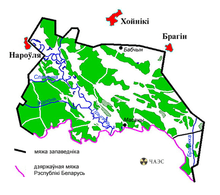Polesie State Radioecological Reserve
| Polesie State Radioecological Reserve | |
|---|---|
|
Палескі дзяржаўны радыяцыйна-экалагічны запаведнік Полесский государственный радиационно-экологический заповедник | |
 | |
| Nearest city | Brahin |
| Coordinates | 51°39′N 29°59′E / 51.650°N 29.983°ECoordinates: 51°39′N 29°59′E / 51.650°N 29.983°E |
| Area | 2162 km² |
| Established | 1988 |
| http://www.zapovednik.by/ | |

Polesie State Radioecological Reserve is a nature reserve in Belarus, which was created to enclose the territory of Belarus most affected by radioactive fallout from the Chernobyl disaster. It adjoins the Chernobyl Exclusion Zone in Ukraine.
History
Two years after the Chernobyl disaster the Belarusian part of the Chernobyl zone was extended to a more highly contaminated area. Then a closed nature reserve was established in Belarus with total area of 1313 km². Reserve was established on July 18, 1988. Before the disaster over 22,000 people lived there in 96 settlements. The population was evacuated after the disaster. In 1993 it expanded by 849 km², making it the biggest Belarusian nature reserve and one of the biggest in Europe.
Fauna and flora
The reserve hosts many rare and endangered species, which thrive here thanks to virtual absence of humans. They include bears, European bison, Przewalski horse, Golden eagle and White-tailed eagle. It is home to the world's largest population of the European marsh turtle. According to PSRER administration, there are 7 reptile, 11 amphibian, 46 mammal, 213 bird and 25 fish species. Of those, 70 are listed in the International Red Book and the Red Book of the Republic of Belarus. Flora includes 1251 registered plants, which is more than two-thirds of the flora of the country, and 18 are listed in the Red Book.[1]
Activities
Administration of PSRER is located in the town of Chojniki. It employs over 700 people and annual budget is 4 million USD. Main activities include:[2]
- Measures to prevent radioactive material from spreading beyond the reserve's borders
- Wildfire prevention
- Radiation monitoring
- Research of nuclear decontamination of soil
- Preventing unauthorized persons from entering the reserve
- Planting trees to prevent air and water erosion
Extra-budgetary activities
The administration uses land in the reserve to earn income in addition to its budget. The purpose is to increase self-sufficiency of the reserve, save money, increase the salaries of employees and contribute positively to the GDP of Belarus. Activities include:
- Forestry and woodworking, sale of timber, firewood, individual carpentry orders
- Growing crops as fodder for animals and also for human consumption
- Purebred horse breeding using forage resources in the reserve
- Pig farming, cattle farming, dairy farming
- Beekeeping, honey production
- Production of fruit tree seedlings
- Providing services to citizens and organizations (transport, sanitation, human decontamination, research on the concentration of radionuclides).
Since 2004 there is a now 230-head herd on the reserve's horse farm. Cattle is being bred to endure the conditions of radioactive contamination, young individuals are sold for further breeding.
During all activities the content of radionuclides is being monitored in order to not exceed the limits.[3]
References
- ↑ Крупнейший в Беларуси и единственный в мире Полесский государственный радиационно-экологический заповедник отмечает свое 15-летие
- ↑ About
- ↑ Внебюджетная деятельность